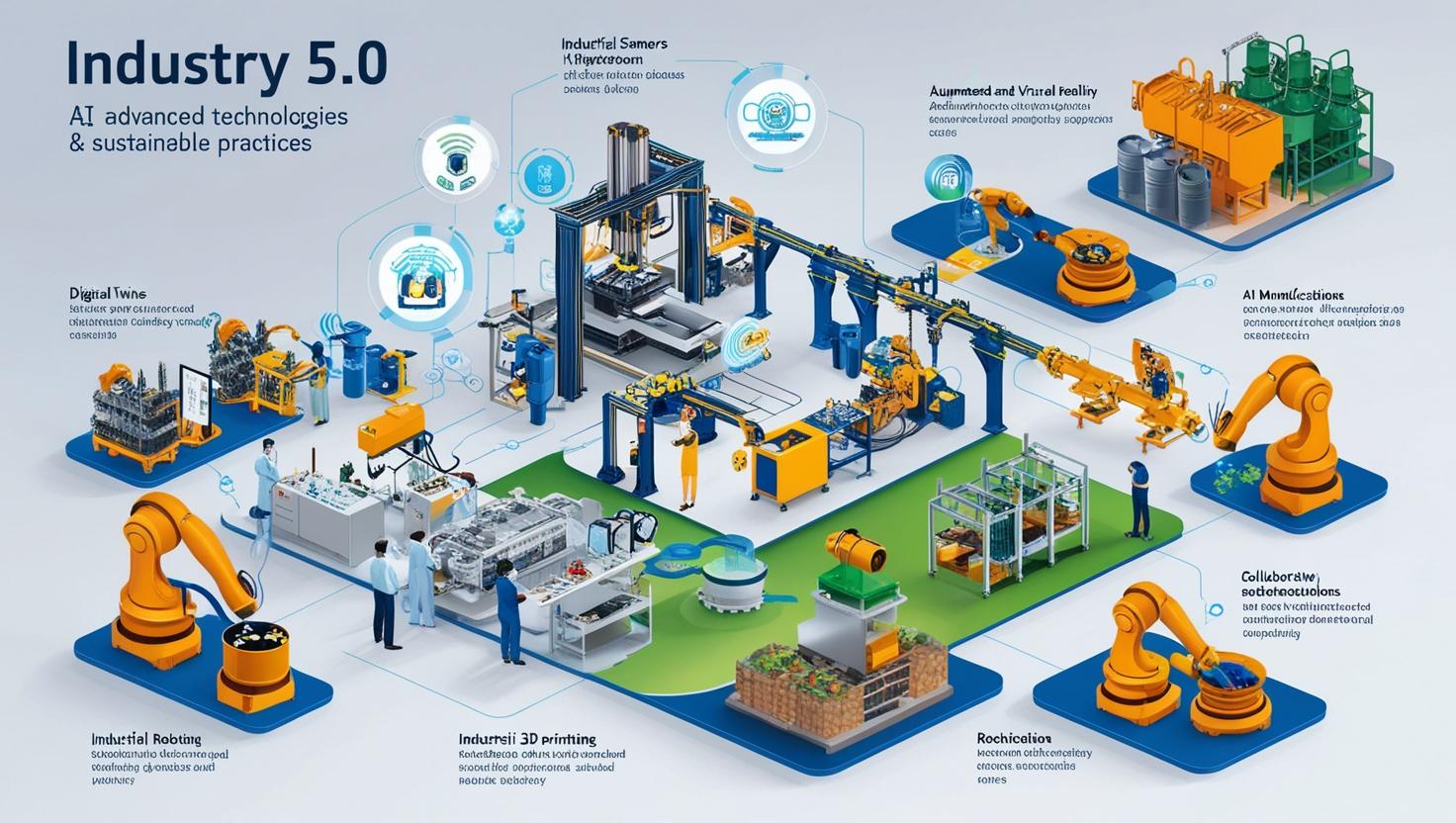The manufacturing industry is undergoing a profound transformation. As businesses navigate the shift from automation-heavy Industry 4.0 to the human-centric, collaborative paradigm of Industry 5.0, emerging technologies are driving innovation, efficiency, and adaptability like never before. This article explores key trends in the Industry 5.0 market and how technologies such as AI, digital twins, robotics, and augmented reality are reshaping the future of manufacturing.
What is Industry 5.0?
Industry 5.0 represents the next phase of industrial evolution, focusing on the collaboration between humans and machines. Unlike Industry 4.0, which emphasizes automation and connectivity, Industry 5.0 blends human intelligence with advanced technologies to create more personalized, flexible, and efficient manufacturing processes. The goal is not only operational excellence but also sustainable and human-centric production.
Key Technologies Driving Industry 5.0
1. Artificial Intelligence in Manufacturing
AI is a cornerstone of Industry 5.0, enabling smart decision-making and predictive analytics. Machine learning algorithms can optimize production schedules, anticipate equipment failures, and streamline supply chain operations. By integrating AI, manufacturers achieve higher efficiency, reduce downtime, and deliver better-quality products tailored to consumer needs.
2. Digital Twins
Digital twin technology creates virtual replicas of physical assets, systems, or processes. These models allow manufacturers to simulate production scenarios, predict maintenance needs, and optimize operations in real-time. Digital twins are critical in minimizing errors, improving safety, and accelerating product development.
3. Industrial Robotics
Robots in Industry 5.0 are designed to collaborate with humans rather than replace them. Collaborative robots (cobots) assist in repetitive or hazardous tasks, improving workplace safety while allowing human workers to focus on creative, high-value activities. Robotics enhances precision, productivity, and flexibility in modern factories.
Download PDF Brochure @ https://www.marketsandmarkets.com/pdfdownloadNew.asp?id=35376359

4. Industrial Sensors
Sensors are the eyes and ears of smart manufacturing. They collect real-time data on machine performance, environmental conditions, and workflow efficiency. This data feeds AI systems and digital twins, enabling predictive maintenance, energy optimization, and smarter decision-making.
5. Augmented and Virtual Reality (AR/VR)
AR and VR technologies are transforming training, maintenance, and design processes. Workers can use AR to overlay instructions on machinery, reducing errors and accelerating learning. VR simulations allow engineers to prototype products virtually, lowering development costs and shortening time-to-market.
6. Industrial 3D Printing
Additive manufacturing, or 3D printing, enables on-demand, customized production. In Industry 5.0, 3D printing supports rapid prototyping, small-batch manufacturing, and highly specialized components. This flexibility allows manufacturers to meet specific customer demands while reducing waste and inventory costs.
Market Opportunities and Growth Drivers
The Industry 5.0 market is poised for rapid growth, driven by several factors:
-
Rising demand for smart, customized manufacturing solutions
-
Integration of AI, IoT, and robotics in factories
-
Need for sustainable and energy-efficient production processes
-
Global push for digital transformation in manufacturing sectors
Industries such as automotive, electronics, aerospace, and healthcare are leading early adoption, seeking enhanced efficiency, reduced costs, and improved product quality.
Challenges in Industry 5.0 Adoption
Despite its potential, Industry 5.0 faces challenges:
-
High implementation costs: Advanced technologies and infrastructure require significant investment.
-
Data security and privacy concerns: Increased connectivity and data sharing raise cybersecurity risks.
-
Skilled workforce gap: Training workers to collaborate with intelligent machines is essential.
-
Integration with legacy systems: Existing manufacturing setups may require extensive upgrades.
Overcoming these challenges is critical for manufacturers to fully realize the benefits of Industry 5.0.
The Future of Manufacturing
Industry 5.0 is more than a technological upgrade—it’s a shift toward human-centric, flexible, and sustainable manufacturing. By leveraging AI, digital twins, robotics, AR/VR, sensors, and 3D printing, manufacturers can enhance efficiency, reduce waste, and deliver personalized products faster. The market for these technologies is expanding rapidly, offering lucrative opportunities for investors, tech providers, and industrial players ready to embrace the next industrial revolution.
As Industry 5.0 continues to evolve, the combination of human intelligence and advanced technologies will redefine manufacturing. Companies that invest strategically in these emerging technologies are likely to gain a competitive edge, improve operational resilience, and drive innovation in an increasingly complex global market.
FAQ: Industry 5.0 Market Insights
1. What is Industry 5.0?
Industry 5.0 is the next evolution in manufacturing that emphasizes collaboration between humans and machines. Unlike Industry 4.0, which focuses on automation, connectivity, and efficiency, Industry 5.0 integrates human creativity with advanced technologies for more personalized, flexible, and sustainable production.
2. Which technologies are driving Industry 5.0?
Key technologies include:
-
Artificial Intelligence (AI): Predictive analytics, optimization, and intelligent decision-making.
-
Digital Twins: Virtual models for real-time simulation, monitoring, and process optimization.
-
Industrial Robotics: Collaborative robots (cobots) that work alongside humans.
-
Industrial Sensors: Real-time monitoring of machines, environment, and workflows.
-
Augmented & Virtual Reality (AR/VR): Enhanced training, design, and maintenance processes.
-
Industrial 3D Printing: Customized and on-demand manufacturing of components.
3. How is AI transforming manufacturing?
AI enables predictive maintenance, optimized production scheduling, and real-time quality control. By analyzing large datasets, AI improves operational efficiency, reduces downtime, and allows manufacturers to deliver more customized products at scale.
4. What are digital twins, and why are they important?
Digital twins are virtual replicas of physical assets or processes. They allow manufacturers to simulate operations, test changes, predict maintenance needs, and optimize workflows without interrupting actual production, reducing costs and errors.
5. How do robotics and cobots contribute to Industry 5.0?
Cobots collaborate safely with humans, performing repetitive or hazardous tasks. This boosts productivity, ensures safety, and frees human workers to focus on high-value, creative, or decision-making tasks.
